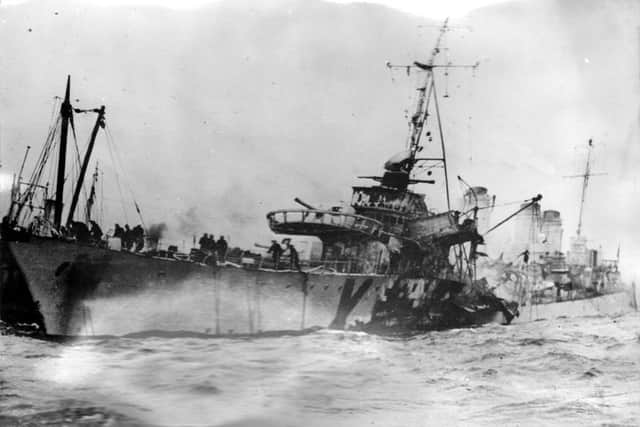Remembering the Maille Breze: The French warship lost in the Clyde without an enemy shot being fired
However, for many living in the town, the memorial also serves as an unofficial tribute to a sunken French vessel that was lost on the Clyde in the largest loss of life in anchorages at that time.
Today marks 82 years since the sinking of the French destroyer the Maille Breze. A total of 28 men lost their lives as the ship sank to the bottom of the Clyde without an enemy missile being fired.
Advertisement
Hide AdAdvertisement
Hide AdThe destroyer had seen plenty of action throughout 1940, crossing the Atlantic escorting battleships and intercepting German naval forces.


It was one of four French vessels mentioned in dispatches for the brave and skilful performance of her crew in attempting to prevent the fall of Norway eight months into the war. However, after surviving hostile waters, the Maille Breeze met a violent end in the friendly and peaceful waters of the Clyde.
Anchored just off Albert Harbour in Greenock for maintenance, the destroyer was rocked by an explosion after a torpedo being worked on by a sailor was fired inwards and downwards through the ship.
Despite efforts to save those below deck, the fire from the initial explosion took hold of the vessel, with 21 sailors trapped below lost. A further seven died in the explosion.
Local rumours flew of potential spies scuttling the ship. Others believe it could have been a cynical destruction of a vessel on the assumption the ship would have joined the Vichy fleet, which adopted a policy of collaboration with the Nazis.
Following the sinking, the remaining munitions were removed, including a number of depth charges, but the stricken vessel remained in the Clyde for the rest of the war.
A total of 21 members of crew were removed when the boat was taken ashore in August 1954, with full Naval Honours and Requiem Mass being held in Greenock, before all the remains were returned to France for burial.
There is a common misconception in the town the memorial that sits looking down from Greenock’s Lyle Hill is to those that perished in the Maillie Breeze, but there is no mention of the destroyer on the monument.
Advertisement
Hide AdAdvertisement
Hide AdThe monument is, in fact, to those in the Free French Navy, established shortly after the sinking of the Maille Breeze.
Explaining the reason for the memorial not commemorating the Maille Breze, historian Vincent Gillen said: “The cross was put up to memorialise the corvettes that were lost and the submarine Surcouf that was lost early in the war.
“It’s a deeply French thing or a political statement that it was Free French only they were going to commemorate, even though the Maille Breze was two months before they arrived in town. It just wasn’t considered part of their cause.”
Explaining why, despite never being for those lost in the Maille Breze, the ship is still associated by locals with the memorial, Mr Gillen said: “It’s in the popular culture of the town. People have memories of this ship blowing up off the Clyde. People thought the Maille Breze was a Free French ship, but it was actually a French navy ship.
“There is an incredible pride in the Free French.
“They have a supreme pride in what they did and what they did against Hitler, so I think they’re unwilling to associate the Maille Breze with it because the crew were interned and then had the choice of going home, or staying, and many of the Maille Breze crew would have gone home and lived in occupied France.”
Despite this, townsfolk still remember those aboard the Maille Breze who sacrificed everything in the fight for freedom when they look at the Free French monument, ensuring that 82 years on, those who perished on April 30, 1940 are not forgotten.
